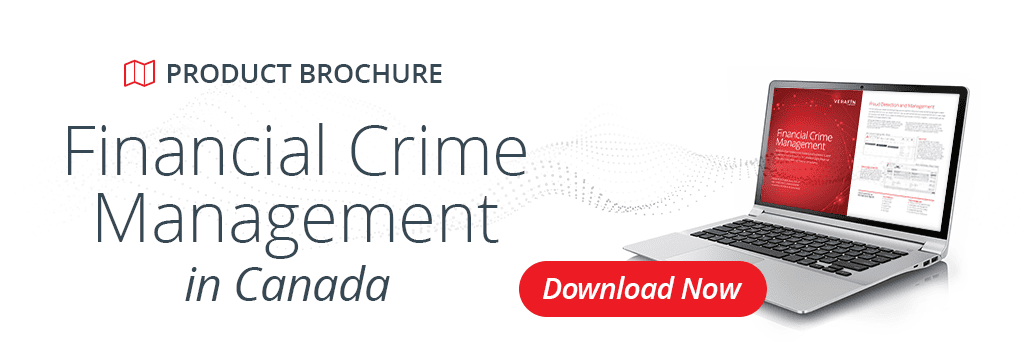Canadian financial institutions are facing significant challenges preventing fraud and money-laundering activities. In our recent year-end webinar, Verafin had the opportunity to speak with Sarah Paquet, Director and Chief Executive Officer of FINTRAC, to discuss the changing landscape of fraud detection and AML in Canada, the impact of technology, and the approaches and solutions needed to respond to growing criminal trends.
The Evolution of Fraud in 2023
As fraud detection and prevention approaches have increased and improved across financial institutions, criminals have leaned heavily into shifting their focus from directly targeting banks and credit unions, to targeting customers. As fraud scams migrate into an individual’s inbox and cell phone, traditional siloed fraud monitoring programs have become inefficient at catching scams before they can play out.
With a myriad of options, technology and flexibility, criminals are utilizing social engineering tactics to target consumers directly with Authorized Push Payment (APP) scams like Business Email Compromise (BEC), romance scams and other deceptive tricks. In 2022, the Canadian Anti-Fraud Centre reported a historic high of over $530 million in losses related to fraud, a 40% increase over the previous year.
Moving Money in 2023
Financial institutions often work in silos, both internally and externally. As fraudsters and criminal organizations accumulate more profits from their illicit activities, they are limited in their ability to use these funds, needing financial institutions as a vector to legitimize their money.
“When we are working to protect victims, we are working to protect our financial system. With all the emerging threats, we cannot look at those risks in silos, but really, looking at the ecosystem of risk and decide how we are going to tackle them.”
– Sarah Paquet, Director and Chief Executive Officer, FINTRAC
For many institutions, this siloed approach of internal fraud and AML departments working separately towards detecting and preventing the same typologies, is not complimentary, leaving a blind spot in the big picture as illegally obtained money tries to enter back into the financial system.
It is at this juncture, where the role of technology can support financial crime management programs by removing internal silos and barriers, enabling cross-functional teams to collaboratively focus on financial crime.
Financial Intelligence: Broadening the Scope of AML Compliance
The most significant and heinous crimes committed across Canada, from human and drug trafficking to terrorist financing and fraud rings, rely on money laundering to hide and legitimize ill-gotten monetary gain.
While AML regulatory compliance is mandatory — requiring dedicated resources, time, and focus — the need for a holistic AML solution is evident. A solution that focuses on reporting outcomes and getting timely and actionable financial intelligence to law enforcement, to aid in proactive investigations and arrests, is essential in identifying money laundering and predicate crimes.
A look to 2024: The Unfolding Canadian Landscape
This past year saw the Government of Canada publish its first AML/ATF strategy, Canada’s Anti-Money Laundering and Anti-Terrorist Financing Regime Strategy 2023-2026. The Regime Strategy provides an overview of the current money laundering and terrorist financing threat environment and presents the Government of Canada’s priority actions to improve Regime performance and outcomes.
“There are a lot of discussions about information sharing, how can we better share information — privacy first, security as well — but, how can we ensure that we work together to put our best foot forward to fight those crimes? This is the kind of discussion that we are going to help move forward, but we need to agree on what we’re trying to do, and going back to those victims, what do we want to do for them?”
– Sarah Paquet, Director and Chief Executive Officer, FINTRAC
Some key considerations that may impact future policy measures and Canadian financial institutions include:
- Strengthening and modernizing the AML/ATF legislative and regulatory framework.
- Addressing risks and vulnerabilities provided by new financial technologies.
- Upholding Canada’s international commitments to implement measures against money laundering and terrorist financing.
Advancing Technology: The Need for Automation
In the battle against financial crime, technology has a significant role to play. As criminals employ increasingly sophisticated tools and tactics, aided by both their own adoption of technology and its growing dependency among customers, financial institutions need to move beyond traditional monitoring approaches to keep pace.
“I think institutions will benefit highly from using technology to do a lot of the triage to automate how you look at your priorities, and then you use the human eye to add strategic value-added work to it.”
– Sarah Paquet, Director and Chief Executive Officer, FINTRAC
Fraud
Fraud monitoring approaches with big data intelligence allow targeted analytics to uncover fraudulent activity across multiple channels, while simultaneously reducing false positives and ensuring quality timely alerts are delivered.
Financial crime investigators need the complete picture of customer activity to identify true risk not constrained to a single transaction channel.
AML
AML compliance and management approaches must be efficient to ensure confidence that regulatory reporting processes are being completed. Financial institutions need an AML solution that automates the often tedious but necessary tasks associated with generating, completing, and filing Suspicious Transaction Reports (STRs), Large Cash Transaction Reports (LCTRs), and Electronic Funds Transfer Report (EFTRs).
AML solutions need to integrate and analyze multiple data sources to reduce false positives and generate high-quality alerts to identify the unusual movement of funds, structuring, and funnel accounts — uncovering money laundering and predicate crimes such as human trafficking activity or fronts for larger criminal organizations.
To learn more about how Verafin can effectively protect your financial institution and customers against fraud and money laundering, please download our Product Brochure Financial Crime Management in Canada.




